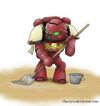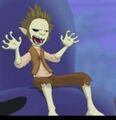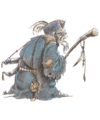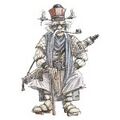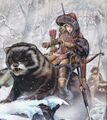Gnome: Difference between revisions
1d4chan>Biggus Berrus (Did some reordering.) |
1d4chan>QuietBrowser (This page really needed a cleanup to bring it into line with the paradigm we've got for the Elf and Dwarf pages. Heck, I think Halfling page is actually cleaner than this. Tried to at least start the process.) |
||
| Line 1: | Line 1: | ||
{{cleanup}} | |||
{{dnd-stub}} | |||
[[Image:4e_Gnome_PHB2.jpg|300px|thumb|right|4e's attempt to make gnomes look badass.]] | [[Image:4e_Gnome_PHB2.jpg|300px|thumb|right|4e's attempt to make gnomes look badass.]] | ||
[[Gnomes]] are | '''Gnomes''' are a fantasy race consisting of small, earthy men and women who possess magical powers and often look prematurely aged. If this sounds like a pretty poor way to describe them, then you're not wrong; the problem is that gnomes are basically the redheaded stepchildren of fantasy gaming, and even that race codifing titan, [[Dungeons & Dragons]], has never been able to give them a solid defining core the way they have done with the [[dwarf]] and [[elf]] races. | ||
==Gnomes in Mythology== | |||
The gnome as a mythical race dates back only as far as the Renaissance, when the writer Paracelsus created them for ''Liber de Nymphis, Sylvanis, Pygmaeis, Salamandris, et Gigantibus etc.'', describing them as small [[elemental]] spirits of the earth. It's believed that he used the term "gnomus" as a result of botching the spelling of gēnomos - "earth-dweller" in Latin. | |||
Gnomes then took off as a result of Romanticism, when the English word "gnome" was coopted as a general blanket term for the "little people" - the vast assortment of small [[fairy]]-people from folklore across the many differing regions of Europe, essentially rolling together creatures like the [[dwarf]], [[goblin]] and [[kobold]] into a single generic term. Drawing upon Paracelsus' original creation, the gnome became a sort of cthonic fey; small, down-to-earth and often quite ugly and masculine in contrast to the masculine-yet-pretty [[elf]] and the very feminine [[fairy]]. | |||
Perhaps the closest thing to a defining image of gnomes has emerged from the various dwarf-like fae races of Switzerland and Germany; very small creatures of the forests and hills who live in harmony with nature, especially the animals, and who are shy but friendly towards humans. This was the school of thought that ultimately birthed the common garden gnome you see all over the place today, and the character David the Gnome, who has his own section elsewhere on this page. | |||
With roots this tangled and confusing, it's no wonder that gnomes continue to struggle to define themselves to this day. | |||
==Gnomes in Dungeons & Dragons== | |||
Gnomes were latecomers to [[Dungeons & Dragons]], not appearing until 1978 in the [[Advanced Dungeons & Dragons]] 1e Player's Handbook - in comparison, the [[Elf]], [[Dwarf]], and [[Hobbit]] - sorry, '''[[Halfling]]''' had been there literally since the beginning, having first shown up in 1974's Men & Magic, the ''very first D&D booklet''. | |||
Right from the start, there were troubles; gnomes had basically been introduced to try and replicate the Fighter/ Mage/Thief trinity in the "shortfolk" races, being the Wizard to the dwarven Fighter and the halfling Rogue. This, unfortunately, did not give them much of a backstory to draw from; D&D gnomes were portrayed as, essentially, a sort of dwarf-elf crossbreed; small, bearded men and homely women who, nonetheless, were playful, friendly, mischievous tricksters with a deep and abiding love of magic and practical jokes. Because, lacking anything better to do with them, they decided to throw them out as the obvious Comic Relief race. | |||
Three editions came and went, and this lore stayed stable; from AD&D 1e to D&D 3e, gnomes were always the afterthought race, the joke race, the short and homely tricksters. Nobody could figure out what to do with them. Some settings toyed with this archetype in their own way - see Subraces - but for the most part, they remained the redhaired stepchildren of D&D. | |||
Finally, by the early days of D&D [[4e]], the developers were sick of this. They decided to take gnomes out of the Player's Handbook and leave them there until they could come up with a decent backstory and "hook" for them, much like how [[halfling]]s went from being blatant [[hobbit]] ripoffs to nomadic hobbits to river & swamp-dwelling merchants & carnies. Gnomes ultimately made their triumphant return in the PHB2, and actually had an interesting backstory. 4e's gnomes had been denizens of the [[Feywild]], alongside the [[Eladrin]], but had spent generations as slaves under the cruel dictatorship of the [[Fomorian]]s; cursed fey giants with powerful magical abilities and mystic eyes. These gnomes worked hard, developing their skills with illusion magic and stealth, and ultimately managed to escape - for the most part. | |||
To this day, they haven't forgotten their time as slaves, and so their culture revolves around both celebrating their freedom and making almost paranoid efforts to protect themselves. They build elaborately hidden bunker-villages, supplementing artful mundane camouflage with powerful illusions and other magical mind-fuckery effects. They hate slavery with a deep and abiding fury, and will do just about anything to avoid going back there. They even have specialist defenders, like the Nightcloaks - [[Paladin]]s armed with illusion magic who act as a combination of secret police and special commandos to eliminate threats before they can strike, and Phantasm Guards - [[Swordmage]]s wielding fear-inducing illusion spells to attack the body and the mind simultaneously. They are surprisingly badass little fuckers, but without going completely [[GrimDark]], so you can still play a comedic gnome if you absolutely want to. | |||
Naturally, in the face of a positive revamp like this, 5th edition promptly threw it all away and went back to their original lore as inconsequential goofy dwarf-lite elf-lite hybrids. | |||
Even [[Pathfinder]] thought that gnomes kind of sucked in 3e, and came up with their own take on them. They decided to double-down on the association of gnomes with wacky, goofball PCs, and so added a dash of [[Kender]] to their racial mix. The gnomes of [[Golarion]] are former residents of the First World, Pathfinder's equivalent to the [[Feywild]], who wound up stranded in the [[Prime Material]] as a race. Deprived of the mystical vitality of their faerie land home, the gnomes are afflicted with a condition called the Bleaching, which slowly sucks the color out of them both literally and metaphorically, until they wind up either dead or as a completely gray and eerily stoic parody of their former selves. Consequently, gnomes seek constant stimulation to thwart the Bleaching, constantly looking to experience the new and surrounding themselves with intense colors, tastes, scents and other sensation, essentially making them an entire race of non-evil [[Slaanesh]]i. | |||
===D&D Gnome Appearances=== | |||
The classic gnome appearance in D&D is essentially a [[dwarf]] with a dash of [[elf]]; a small, squat humanoid who usually is described as both fairly homely and seeming to age quickly, giving them wrinkly faces and pronounced beards & mustaches. Unlike dwarves, they have no cultural attachment to their beards, and indeed often shave them into goatees or similarly small, neatly kept affairs to keep them out of their way. In AD&D, gnomes are most known for their prodigious noses. The elfin aspect mostly shines through in long, pointy ears. | |||
The Feywild Gnome of 4th edition abandons the dwarfish elements; instead, they look like scaled-down [[eladrin]], with wild, spiky hair. They're surprisingly attractive, compared to the gnomes of past editions, or at least to AD&D. | |||
The Golarion Gnome of Pathfinder looks deliberately like a chibi anime character; weirdly sized facial features that invoke the classic anime look (seemingly too small mouth, near-absent nose, huge eyes) are actually canonical to their lore, and they come in a vast variety of different and weird skin, hair and eye colors. This is intended to help emphasize their fey, alien natures when compared to dwarves and halflings, and in fairness it actually works pretty well. | |||
===Gnomish Subraces=== | |||
Rock Gnome | |||
Forest Gnome | |||
[[Svirfneblin]] | |||
Skygnome | |||
Tinker Gnome | |||
Thinker Gnome | |||
Feywild Gnome | |||
Golarion Gnome | |||
===Gnomish Religion=== | |||
Gnomes in D&D worship a pantheon that centers around [[Garl Glittergold]], their patron and analogous to [[Moradin]] or [[Corellon]]. | |||
===PC Stats=== | |||
====5th Edition==== | |||
::Ability Score: +2 Intelligence. | |||
::Typical Alignment: Any Good Alignment | |||
::Size: Small. Between 3 and 4 feet tall, and clocking in at an average of 40 pounds. | |||
::Speed: Base walking speed of 25 feet. | |||
::Darkvision | |||
::Gnome Cunning: Advantage on all mental (Intelligence, Wisdom, and Charisma) saving throws against magic. | |||
::Languages: Common, Gnomish | |||
'''Forest Gnomes''' | |||
::Ability Score: +1 Dexterity | |||
::Natural Illusionist: Free Minor Illusion Cantrip, with Intelligence as the modifier. | |||
::Speak with Small Beasts: You can communicate simple ideas with Small or smaller beasts through sounds and gestures. Be prepared for your party to ask if you're having a stroke if you use this. | |||
'''Rock Gnome''' | |||
::Ability Score: +1 Constitution | |||
::Artificer's Lore: Double Proficiency bonus when making History checks related to magic items, alchemical objects, or technological devices. | |||
::Tinker: Proficiency with Tinker's Tools. Using the tools, you can spend an hour and 10 gp worth of materials to construct a Tiny clockwork device. It ceases to function after 24 hours unless you spend 1 hour repairing it, or you use an action to dismantle it. At that time, you can reclaim the materials used to create it. You can only have three active at one time. | |||
* Clockwork Toy: The toy is a clockwork animal, monster, or person. When activated and placed on the ground, they toy moves five feet in a random direction. It makes noises appropriate to the creature it represents. | |||
* Fire Starter: It's a lighter. Use requires an action. | |||
* Music Box: When opened, the box plays a single song at a moderate volume. The box stops playing upon reaching the songs end or when it's closed. | |||
'''Deep Gnome (Svirfneblin)''' | |||
::Ability Score: +1 Dex | |||
::Actually have shorter lives. Only 200-250 years, and consequently, are considered full grown adults by 25. | |||
::Typical Alignment: Any Neutral Alignment. | |||
::Superior Darkvision | |||
::Stone Camouflage: Advantage on Stealth checks to hide in rocky terrain. | |||
::Languages: Common, Gnomish, Undercommon | |||
::Optional Feat: Svirfneblin Magic. While the other members of the Underdark Crew automatically get their magic, the svirf's have to waste an ASI to get a feat to get theirs. That said, it includes: | |||
* Nondetection (at-will, self only) | |||
* Blindness/Deafness (once-a-day, long rest recharge) | |||
* Blur (once-a-day, long rest recharge) | |||
* Disguise Self (once-a-day, long rest recharge) | |||
* Intelligence is their modifier for all spells. | |||
==Gnomes vs. Dwarves== | |||
Part of the reason gnomes struggle to this day with finding an identity is that they overlap too much with dwarves. Which is to be expected, since gnomes (at least the iconic D&D version) were basically made by throwing together various dwarf-like mythical beings into one and dwarves were made to be expies of Nordic dwarves by way of [[Tolkien]]. It's far too easy for gnomes to fall into the trap of defining themselves as being "whatever dwarves aren't" - and if that's no longer the case, the gnomish identity struggled. The ability for dwarves to cast arcane magic alone was a huge blow against them when 3e came out. | |||
Another part of the problem is that, really, anything gnomes can do, dwarves can do. This is most readily seen in how dwarves are often the go-to "tech guy" race in settings that don't adhere to [[Medieval Stasis]], despite the gnome's increasing attempts to be associated with fantasy technology and [[magitek]]. | |||
==The Tinker Gnome Phenomena== | ==The Tinker Gnome Phenomena== | ||
| Line 38: | Line 109: | ||
Perhaps fortunately, the tinker gnome phenomena has mostly become associated in the modern era with the gnomes of [[Warcraft]], who are kooky and like to try the outrageous, but also prize functionality and safety (in contrast to [[goblin]]s, who are happy to risk being blown to bits if it means they get it working faster). | Perhaps fortunately, the tinker gnome phenomena has mostly become associated in the modern era with the gnomes of [[Warcraft]], who are kooky and like to try the outrageous, but also prize functionality and safety (in contrast to [[goblin]]s, who are happy to risk being blown to bits if it means they get it working faster). | ||
== | ==David the Gnome== | ||
If you hang out on /tg/ long enough, eventually, you're going to see a macro. A still from a cartoon, depicting a garden gnome-like figure with a blue shirt and a red hat. He's frowning intensely and has both hands clenched into fists, and emblazoned on the pic will be some variant of "I'm about to slap your shit". | |||
'' | This is David the Gnome. Originally the star of a Swedish author's children's books about gnomes who tried to provide good eco-friendly lessons to young readers, it was transformed into a very popular animated series in the mid 1980s. In a mountain forest, David lives the life of a goodly [[druid]]; telling eco-lessons to the audience off-screen whilst on-screen rescuing cute animals from danger, patching up their injuries and curing their sicknesses, all whilst protecting the forest from beings who would harm it. | ||
' | It is perhaps most famous for its soul-crushing ending. See, throughout the series, we're told that gnomes only live to be 400 years old - and both David and his wife are 399 at the start of the series. Most cartoons would have just ended in some upbeat fashion, but not The World of David The Gnome. Oh no! Instead, those tuning in for the final episode got to see the clock tick around to the gnomes' 400th year, whereupon they stagger out into the forest, withering quickly under the onslaught of age, share one final embrace, and then turn into a pair of young trees. And then just to reinforce that they're dead, we see their ghosts/souls emerge from the trees, hug each other again, and go dancing off into the sky to the gnomish equivalent of Heaven, all whilst David's series-long partner, a fox named Swift, lays down at the foot of the trees and cries his heart out. | ||
Sweet fucking Garl Glittergold, that was a depressing ending... | |||
== Famous Gnomes == | == Famous Gnomes == | ||
Revision as of 06:55, 30 October 2017
>
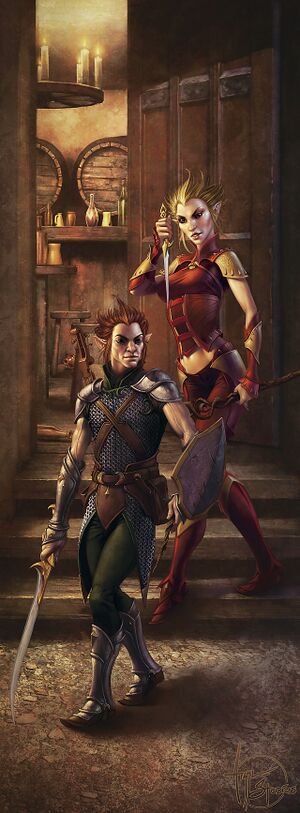
Gnomes are a fantasy race consisting of small, earthy men and women who possess magical powers and often look prematurely aged. If this sounds like a pretty poor way to describe them, then you're not wrong; the problem is that gnomes are basically the redheaded stepchildren of fantasy gaming, and even that race codifing titan, Dungeons & Dragons, has never been able to give them a solid defining core the way they have done with the dwarf and elf races.
Gnomes in Mythology
The gnome as a mythical race dates back only as far as the Renaissance, when the writer Paracelsus created them for Liber de Nymphis, Sylvanis, Pygmaeis, Salamandris, et Gigantibus etc., describing them as small elemental spirits of the earth. It's believed that he used the term "gnomus" as a result of botching the spelling of gēnomos - "earth-dweller" in Latin.
Gnomes then took off as a result of Romanticism, when the English word "gnome" was coopted as a general blanket term for the "little people" - the vast assortment of small fairy-people from folklore across the many differing regions of Europe, essentially rolling together creatures like the dwarf, goblin and kobold into a single generic term. Drawing upon Paracelsus' original creation, the gnome became a sort of cthonic fey; small, down-to-earth and often quite ugly and masculine in contrast to the masculine-yet-pretty elf and the very feminine fairy.
Perhaps the closest thing to a defining image of gnomes has emerged from the various dwarf-like fae races of Switzerland and Germany; very small creatures of the forests and hills who live in harmony with nature, especially the animals, and who are shy but friendly towards humans. This was the school of thought that ultimately birthed the common garden gnome you see all over the place today, and the character David the Gnome, who has his own section elsewhere on this page.
With roots this tangled and confusing, it's no wonder that gnomes continue to struggle to define themselves to this day.
Gnomes in Dungeons & Dragons
Gnomes were latecomers to Dungeons & Dragons, not appearing until 1978 in the Advanced Dungeons & Dragons 1e Player's Handbook - in comparison, the Elf, Dwarf, and Hobbit - sorry, Halfling had been there literally since the beginning, having first shown up in 1974's Men & Magic, the very first D&D booklet.
Right from the start, there were troubles; gnomes had basically been introduced to try and replicate the Fighter/ Mage/Thief trinity in the "shortfolk" races, being the Wizard to the dwarven Fighter and the halfling Rogue. This, unfortunately, did not give them much of a backstory to draw from; D&D gnomes were portrayed as, essentially, a sort of dwarf-elf crossbreed; small, bearded men and homely women who, nonetheless, were playful, friendly, mischievous tricksters with a deep and abiding love of magic and practical jokes. Because, lacking anything better to do with them, they decided to throw them out as the obvious Comic Relief race.
Three editions came and went, and this lore stayed stable; from AD&D 1e to D&D 3e, gnomes were always the afterthought race, the joke race, the short and homely tricksters. Nobody could figure out what to do with them. Some settings toyed with this archetype in their own way - see Subraces - but for the most part, they remained the redhaired stepchildren of D&D.
Finally, by the early days of D&D 4e, the developers were sick of this. They decided to take gnomes out of the Player's Handbook and leave them there until they could come up with a decent backstory and "hook" for them, much like how halflings went from being blatant hobbit ripoffs to nomadic hobbits to river & swamp-dwelling merchants & carnies. Gnomes ultimately made their triumphant return in the PHB2, and actually had an interesting backstory. 4e's gnomes had been denizens of the Feywild, alongside the Eladrin, but had spent generations as slaves under the cruel dictatorship of the Fomorians; cursed fey giants with powerful magical abilities and mystic eyes. These gnomes worked hard, developing their skills with illusion magic and stealth, and ultimately managed to escape - for the most part.
To this day, they haven't forgotten their time as slaves, and so their culture revolves around both celebrating their freedom and making almost paranoid efforts to protect themselves. They build elaborately hidden bunker-villages, supplementing artful mundane camouflage with powerful illusions and other magical mind-fuckery effects. They hate slavery with a deep and abiding fury, and will do just about anything to avoid going back there. They even have specialist defenders, like the Nightcloaks - Paladins armed with illusion magic who act as a combination of secret police and special commandos to eliminate threats before they can strike, and Phantasm Guards - Swordmages wielding fear-inducing illusion spells to attack the body and the mind simultaneously. They are surprisingly badass little fuckers, but without going completely GrimDark, so you can still play a comedic gnome if you absolutely want to.
Naturally, in the face of a positive revamp like this, 5th edition promptly threw it all away and went back to their original lore as inconsequential goofy dwarf-lite elf-lite hybrids.
Even Pathfinder thought that gnomes kind of sucked in 3e, and came up with their own take on them. They decided to double-down on the association of gnomes with wacky, goofball PCs, and so added a dash of Kender to their racial mix. The gnomes of Golarion are former residents of the First World, Pathfinder's equivalent to the Feywild, who wound up stranded in the Prime Material as a race. Deprived of the mystical vitality of their faerie land home, the gnomes are afflicted with a condition called the Bleaching, which slowly sucks the color out of them both literally and metaphorically, until they wind up either dead or as a completely gray and eerily stoic parody of their former selves. Consequently, gnomes seek constant stimulation to thwart the Bleaching, constantly looking to experience the new and surrounding themselves with intense colors, tastes, scents and other sensation, essentially making them an entire race of non-evil Slaaneshi.
D&D Gnome Appearances
The classic gnome appearance in D&D is essentially a dwarf with a dash of elf; a small, squat humanoid who usually is described as both fairly homely and seeming to age quickly, giving them wrinkly faces and pronounced beards & mustaches. Unlike dwarves, they have no cultural attachment to their beards, and indeed often shave them into goatees or similarly small, neatly kept affairs to keep them out of their way. In AD&D, gnomes are most known for their prodigious noses. The elfin aspect mostly shines through in long, pointy ears.
The Feywild Gnome of 4th edition abandons the dwarfish elements; instead, they look like scaled-down eladrin, with wild, spiky hair. They're surprisingly attractive, compared to the gnomes of past editions, or at least to AD&D.
The Golarion Gnome of Pathfinder looks deliberately like a chibi anime character; weirdly sized facial features that invoke the classic anime look (seemingly too small mouth, near-absent nose, huge eyes) are actually canonical to their lore, and they come in a vast variety of different and weird skin, hair and eye colors. This is intended to help emphasize their fey, alien natures when compared to dwarves and halflings, and in fairness it actually works pretty well.
Gnomish Subraces
Rock Gnome
Forest Gnome
Skygnome
Tinker Gnome
Thinker Gnome
Feywild Gnome
Golarion Gnome
Gnomish Religion
Gnomes in D&D worship a pantheon that centers around Garl Glittergold, their patron and analogous to Moradin or Corellon.
PC Stats
5th Edition
- Ability Score: +2 Intelligence.
- Typical Alignment: Any Good Alignment
- Size: Small. Between 3 and 4 feet tall, and clocking in at an average of 40 pounds.
- Speed: Base walking speed of 25 feet.
- Darkvision
- Gnome Cunning: Advantage on all mental (Intelligence, Wisdom, and Charisma) saving throws against magic.
- Languages: Common, Gnomish
Forest Gnomes
- Ability Score: +1 Dexterity
- Natural Illusionist: Free Minor Illusion Cantrip, with Intelligence as the modifier.
- Speak with Small Beasts: You can communicate simple ideas with Small or smaller beasts through sounds and gestures. Be prepared for your party to ask if you're having a stroke if you use this.
Rock Gnome
- Ability Score: +1 Constitution
- Artificer's Lore: Double Proficiency bonus when making History checks related to magic items, alchemical objects, or technological devices.
- Tinker: Proficiency with Tinker's Tools. Using the tools, you can spend an hour and 10 gp worth of materials to construct a Tiny clockwork device. It ceases to function after 24 hours unless you spend 1 hour repairing it, or you use an action to dismantle it. At that time, you can reclaim the materials used to create it. You can only have three active at one time.
- Clockwork Toy: The toy is a clockwork animal, monster, or person. When activated and placed on the ground, they toy moves five feet in a random direction. It makes noises appropriate to the creature it represents.
- Fire Starter: It's a lighter. Use requires an action.
- Music Box: When opened, the box plays a single song at a moderate volume. The box stops playing upon reaching the songs end or when it's closed.
Deep Gnome (Svirfneblin)
- Ability Score: +1 Dex
- Actually have shorter lives. Only 200-250 years, and consequently, are considered full grown adults by 25.
- Typical Alignment: Any Neutral Alignment.
- Superior Darkvision
- Stone Camouflage: Advantage on Stealth checks to hide in rocky terrain.
- Languages: Common, Gnomish, Undercommon
- Optional Feat: Svirfneblin Magic. While the other members of the Underdark Crew automatically get their magic, the svirf's have to waste an ASI to get a feat to get theirs. That said, it includes:
- Nondetection (at-will, self only)
- Blindness/Deafness (once-a-day, long rest recharge)
- Blur (once-a-day, long rest recharge)
- Disguise Self (once-a-day, long rest recharge)
- Intelligence is their modifier for all spells.
Gnomes vs. Dwarves
Part of the reason gnomes struggle to this day with finding an identity is that they overlap too much with dwarves. Which is to be expected, since gnomes (at least the iconic D&D version) were basically made by throwing together various dwarf-like mythical beings into one and dwarves were made to be expies of Nordic dwarves by way of Tolkien. It's far too easy for gnomes to fall into the trap of defining themselves as being "whatever dwarves aren't" - and if that's no longer the case, the gnomish identity struggled. The ability for dwarves to cast arcane magic alone was a huge blow against them when 3e came out.
Another part of the problem is that, really, anything gnomes can do, dwarves can do. This is most readily seen in how dwarves are often the go-to "tech guy" race in settings that don't adhere to Medieval Stasis, despite the gnome's increasing attempts to be associated with fantasy technology and magitek.
The Tinker Gnome Phenomena
As part of the general and ongoing attempt to make gnomes interesting, many settings have tried the path of making them tinkers. The general logic is that they have a vaguely-dwarfish industriousness and affinity for the sciences, but a distinctly undwarfy knack for magic, inventiveness, and prizing the new over the tried, true and traditional. So, they are a logical fit for a race that tries to create new inventions and things. In settings featuring them, dwarves may be better at rune-crafting or forging masterwork gear, but gnomes will be the ones who create steampunk and guns.
The very first example of this was in Mystara, where the gnomish civilization is a flying city-state, defended by manned machine-gun turrets and fully-functional biplanes. Sadly, like most Mystaran stuff, it is generally unknown except to a few ancient neckbeards.
The most famous example, sadly, are the Minoi of Dragonlance. Unfortunately, as with the Gully Dwarves and the notorious Kender, Tinker Gnomes were intended to be a Comic Relief race. So, once again, the authors failed to realise that A: traits that make one character amusing often become boring/embarrassing/ridiculous when applied to a whole race, and B: a race that is intended to be playable shouldn't come with traits that seem tailor-made for a character to be used as an excuse to piss off the rest of the party. With lore that they used to be humans who served Reorx, the God of Creation, during the mythic era, only to anger him and be cursed and cast from his forge, condemned to never again be able to properly apply the creativity he had given them, the end result is that Krynnish Tinker Gnomes are a race of bungling idiots who deliberately overcomplicate their machinery because they find the extremes of Rube Goldberg design to be more aesthetically pleasing and "scientific". Most gnome-fans hate them, as they are implicitly called out as being responsible for Krynn's Medieval Stasis. Even in The Complete Book of Gnomes & Halflings, there's quotes from "real" gnomes denying that Tinker Gnomes are any relation to them, showing that TSR itself may have been aware of what sort of hack writers they had behind them.
Perhaps fortunately, the tinker gnome phenomena has mostly become associated in the modern era with the gnomes of Warcraft, who are kooky and like to try the outrageous, but also prize functionality and safety (in contrast to goblins, who are happy to risk being blown to bits if it means they get it working faster).
David the Gnome
If you hang out on /tg/ long enough, eventually, you're going to see a macro. A still from a cartoon, depicting a garden gnome-like figure with a blue shirt and a red hat. He's frowning intensely and has both hands clenched into fists, and emblazoned on the pic will be some variant of "I'm about to slap your shit".
This is David the Gnome. Originally the star of a Swedish author's children's books about gnomes who tried to provide good eco-friendly lessons to young readers, it was transformed into a very popular animated series in the mid 1980s. In a mountain forest, David lives the life of a goodly druid; telling eco-lessons to the audience off-screen whilst on-screen rescuing cute animals from danger, patching up their injuries and curing their sicknesses, all whilst protecting the forest from beings who would harm it.
It is perhaps most famous for its soul-crushing ending. See, throughout the series, we're told that gnomes only live to be 400 years old - and both David and his wife are 399 at the start of the series. Most cartoons would have just ended in some upbeat fashion, but not The World of David The Gnome. Oh no! Instead, those tuning in for the final episode got to see the clock tick around to the gnomes' 400th year, whereupon they stagger out into the forest, withering quickly under the onslaught of age, share one final embrace, and then turn into a pair of young trees. And then just to reinforce that they're dead, we see their ghosts/souls emerge from the trees, hug each other again, and go dancing off into the sky to the gnomish equivalent of Heaven, all whilst David's series-long partner, a fox named Swift, lays down at the foot of the trees and cries his heart out.
Sweet fucking Garl Glittergold, that was a depressing ending...
Famous Gnomes
- The only Gnome who has left a written record of his travels is Dimkin of the Stump, whose journal makes reference to a mysterious land with a vast plain of turnips and enormous landmarks that seem almost like constructions.
- High Tinker Gelbin Mekkatorque
- Informally known as King of the Gnomes (in exile), he is actually an elected leader, holding the position for an indefinite term. He and a substantial fraction of the total gnome population fled from their homes in Gnomeregan after an environm*BLAM* World of Warcraft shit is HERESY!
- Underpants Gnomes
- ... those little shits stole my boxers.
- David the Gnome
- He will slap your shit.
- Tinker, tailor, wizard, turnip. He seems stupid, until his army of knife-wielding gibbon commandos invades your house, saves his childhood sweetheart, and assassinates you. Anything is possible with that many heavily-armed apes.
Gallery
-
He's a monster, rawr.
-
What gnomes look like in 2e.
-
-
5e really plays up their elven ancestry.
-
Being Small means you can ride animals that Medium-sized humanoids cannot, like DIRE WEASLES.
External links
| Dungeons & Dragons 1st Edition Races | |
|---|---|
| Basic Set | Dwarf • Elf • Hobbit • Human |
| Creature Crucible 1 | Brownie • Centaur • Dryad • Faun • Hsiao • Leprechaun • Pixie • Pooka • Redcap • Sidhe • Sprite • Treant • Wood Imp • Wooddrake |
| Creature Crucible 2 | Faenare • Gnome • Gremlin • Harpy • Nagpa • Pegataur • Sphinx • Tabi |
| Creature Crucible 3 | Kna • Kopru • Merrow • Nixie • Sea Giant • Shark-kin • Triton |
| Dragon Magazine | Cayma • Gatorman • Lupin • N'djatwa • Phanaton • Rakasta • Shazak • Wallara |
| Hollow World | Beastman • Brute-Man • Hutaakan • Krugel Orc • Kubitt • Malpheggi Lizard Man |
| Known World | Bugbear • Goblin • Gnoll • Hobgoblin • Kobold • Ogre • Troll |
| Dungeons & Dragons 2nd Edition Races | |
|---|---|
| Core | Dwarf • Elf • Gnome • Half-Elf • Half-Orc • Halfling • Human |
| Dark Sun | Aarakocra • Half-Giant • Mul • Pterran • Thri-kreen |
| Dragonlance | Draconian • Irda • Kender • Minotaur |
| Mystara | Aranea • Ee'ar • Enduk • Lizardfolk (Cayma • Gurrash • Shazak) • Lupin • Manscorpion • Phanaton • Rakasta • Tortle • Wallara |
| Oriental Adventures | Korobokuru • Hengeyokai • Spirit Folk |
| Planescape | Aasimar • Bariaur • Genasi • Githyanki • Githzerai • Modron • Tiefling |
| Spelljammer | Dracon • Giff • Grommam • Hadozee • Hurwaeti • Rastipede • Scro • Xixchil |
| Ravenloft: | Broken One • Flesh Golem • Half-Vistani • Therianthrope |
| Complete Book Series | Alaghi • Beastman • Bugbear • Bullywug • Centaur • Duergar • Fremlin • Firbolg • Flind • Gnoll • Goblin • Half-Ogre • Hobgoblin • Kobold • Mongrelfolk • Ogre • Ogre Mage • Orc • Pixie • Satyr • Saurial • Svirfneblin • Swanmay • Voadkyn • Wemic |
| Dragon Magazine | Half-Dryad • Half-Satyr • Uldra • Xvart |
| Dungeons & Dragons 4th Edition Races | |
|---|---|
| Player's Handbook 1 | Dragonborn • Dwarf • Eladrin • Elf • Half-Elf • Halfling • Human • Tiefling |
| Player's Handbook 2 | Deva • Gnome • Goliath • Half-Orc • Shifter |
| Player's Handbook 3 | Githzerai • Minotaur • Shardmind • Wilden |
| Monster Manual 1: | Bugbear • Doppelganger • Githyanki • Goblin • Hobgoblin • Kobold • Orc |
| Monster Manual 2 | Bullywug • Duergar • Kenku |
| Dragon Magazine | Gnoll • Shadar-kai |
| Heroes of Shadow | Revenant • Shade • Vryloka |
| Heroes of the Feywild | Hamadryad • Pixie • Satyr |
| Eberron's Player's Guide | Changeling • Kalashtar • Warforged |
| The Manual of the Planes | Bladeling |
| Dark Sun Campaign Setting | Mul • Thri-kreen |
| Forgotten Realms Player's Guide | Drow • Genasi |
| The Races of Pathfinder | |
|---|---|
| Player's Handbook: | Dwarf - Elf - Gnome - Half-Elf - Half-Orc - Halfling - Human |
| Advanced Race Guide: |
Aasimar - Catfolk - Changeling - Dhampir - Duergar Drow - Fetchling - Gillman - Goblin - Grippli - Hobgoblin Ifrit - Kitsune - Kobold - Merfolk - Nagaji - Orc - Oread Ratfolk - Samsaran - Strix - Suli - Svirfneblin - Sylph Tengu - Tiefling - Undine - Vanara - Vishkanya - Wayang |
| Bestiaries: | Android - Astomoi - Caligni - Deep One Hybrid - Gathlain Gnoll - Kasatha - Munavri - Naiad - Orang-Pendak Reptoid - Rougarou - Shabti - Trox - Yaddithian |
| Adventure Paths: | Being of Ib - Kuru |
| Inner Sea Races: | Ghoran - Monkey Goblin - Lashunta - Skinwalker Syrinx - Triaxian - Wyrwood - Wyvaran |
| Ultimate Wilderness: | Vine Leshy |
| Blood of the Sea: | Adaro - Cecaelia - Grindylow - Locathah - Sahuagin - Triton |
| Planar Adventures: | Aphorite - Duskwalker - Ganzi |
